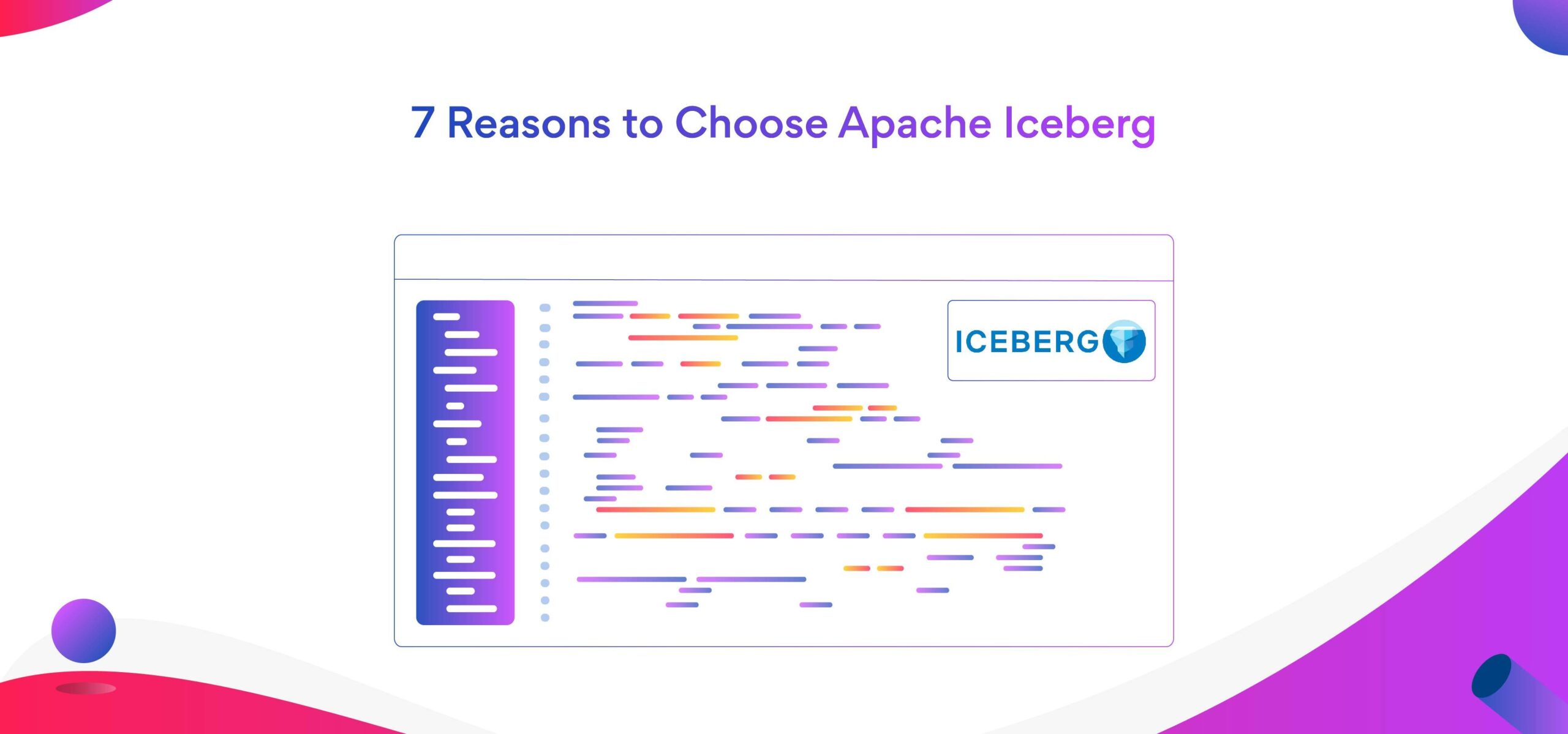7 Reasons to Choose Apache Iceberg
What is Apache Iceberg? What problem does Apache Iceberg solve? Is Apache Iceberg a data lake? When was Apache Iceberg released?
This blog will help you answer all these questions.
Organizations today have a high number of large datasets to store and analyze. Data lakes help organizations store both structured and unstructured data at any scale. In addition, data lakes help process the data as per requirement and enable organizations to make sound data-driven decisions.
What is Apache Iceberg?
Apache Iceberg is a new open table format designed for managing, organizing, and tracking all the files that make up a table. The table format helps break down complex datasets stored in popular file formats like Apache Parquet, Optimized row columnar, and AVRO, among others.

Apache Iceberg is a high-performance table format.
Apache Iceberg architecture keeps track of all the files using tree structures. The table format consists of a clear path to the metadata file that stores all individual data files.
How is Apache Iceberg an improvement on Apache Hive?
Introduced by Netflix, Apache Iceberg solves several data consistency and performance issues in Apache Hive. Data in Apache Hive is at the folder level that requires users to perform file list operations for working with data tables. During file list operations, data can appear missing for different object stores. Also, during updates of large partitions, entire partitions must require rewriting to be available at a new location.
Moreover, as datasets grow in Apache Hive, data querying takes quite a long due to complex directory structure and an additional layer of overheads. Users must also track the physical layout of tables while writing queries.
The data structure of Apache Iceberg is similar to Hadoop wherein the object storage maintains and manages metadata and data layers. Unlike Apache Hive, adding, removing, and updating data are fast and easy as users pull files directly at the file level instead of the partition level.
Apache Iceberg architecture provides a snapshot querying model that maps data when it grows at scale. By using the manifest and metadata files, the performance of data querying remains high and fast, with data accessible at the file level.
Here’s why you should choose Apache Iceberg
-
Schema evolution
In Apache Iceberg, schema evolution changes are independent and have no side effects. Schema evolution involves metadata changes that uniquely identify column names in the metadata layers with the help of ids.
Apache Iceberg architecture allows the addition, removal, and renaming of existing columns. Additionally, the table format enables changing the order of columns, widening columns, and updating map keys, struct fields, and list elements. -
Hidden partitioning
Apache Iceberg offers hidden partitioning that allows you to search queries without knowing the various types of partitioning within the table.
Iceberg offers various partitioning options for timestamps, including day, date, year, and month. Also, users can partition columns using hash buckets, truncation, and identity options. -
Flexible SQL
Apache Iceberg offers support for implementing analytical queries on data lakes at scale. When data grow at scale, the Apache Iceberg architecture enables flexible SQL commands to update existing rows, merge new data and delete rows and columns from tables.
Related Post: Top 21 SQL Interview Questions and Answers -
Rollback and time travel
Apache Iceberg enables developers to view data at any given point in time. The Apache Iceberg architecture stores and maintains records of snapshots of the table.
There are two rollback and time travel options, namely snapshot-id and as-of-timestamp. As-of-timestamps in milliseconds allow you to select the current snapshot at a timestamp. On the other hand, snapshot-id allows you to select a specific table snapshot. -
ACID compliance
ACID expands to atomicity, consistency, isolation, and durability, which are a set of properties applied to database transactions. Table formats without ACID compliance take a long time to answer data queries.
Apache Iceberg makes queries on the files cost-effective and efficient by reducing the amount of data. The Apache Iceberg architecture holds metadata on files to reduce data complexity and query response time. -
Supports multiple query engines and file formats
Apache Iceberg offers flexibility to developers by allowing access to different query engines and file formats. Developers can choose from query engines like Hadoop, Trino, Hive, Flink, Spark, and more. Similarly, developers can select different file formats like Apache Parquet, Avro, and ORC, among others.
The flexibility of Apache Iceberg architecture helps developers choose the best option on a case-by-case basis. Iceberg offers easy adaptability and high stability for several tools that can integrate with table formats. -
AWS Integrations
Apache Iceberg uses the iceberg module to provide smooth integration with different AWS services. Apache Iceberg architecture supports AWS integration for engines including Spark, Flink, and Apache Hive.
Similarly, the table format offers several custom catalog options that include the glue catalog, DynamoDB catalog, and RDS JDBC catalog. Developers can choose from different catalog-specific AWS documentation to set up and build the Iceberg catalog.
Check out this blog to know all about the AWS certification guide.
Summary
Apache Iceberg is a new and improved table format that facilitates the smooth processing of data. By providing quick collaboration, safe and reliable data querying, and integration with several engines and catalogs, Apache Iceberg is the popular choice for big data platforms.
Organizations realize the importance of lake house style architectures that can evolve and scale seamlessly. Hence, companies are looking to hire skilled developers with good knowledge of the latest table formats and styles.
Are you familiar with Apache Iceberg?
If yes, try Turing.
Turing offers long-term career growth and high-paying remote US jobs from the comfort of your home. Visit the Apply for Jobs page to know more!
FAQs
- When was Apache Iceberg released?
Apache Iceberg was released on Aug 15, 2021. - Is Apache Iceberg a data lake?
No, Apache Iceberg is a table format that helps manage data in data lakes. A data lake is a storage system that collects and stores structured and unstructured data at any scale. - How do you read and write data in Apache Iceberg?
To read and write data in Apache Iceberg, developers can use the data frame feature of different querying engines like Spark and Flink, among others.
Join a network of the world's best developers and get long-term remote software jobs with better compensation and career growth.












